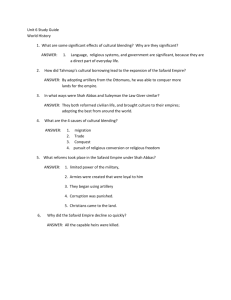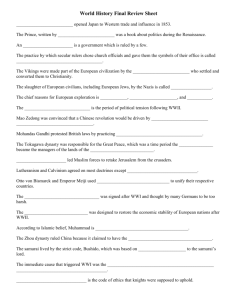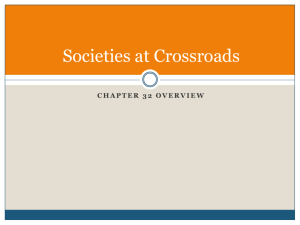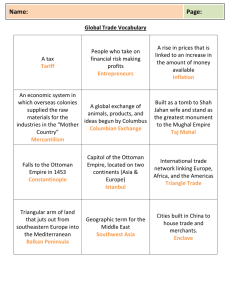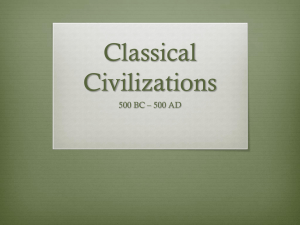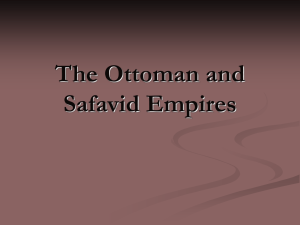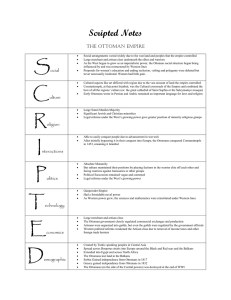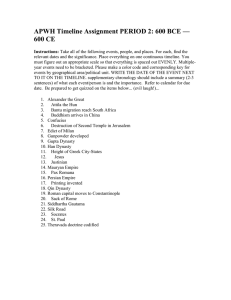Muslim Empires
advertisement
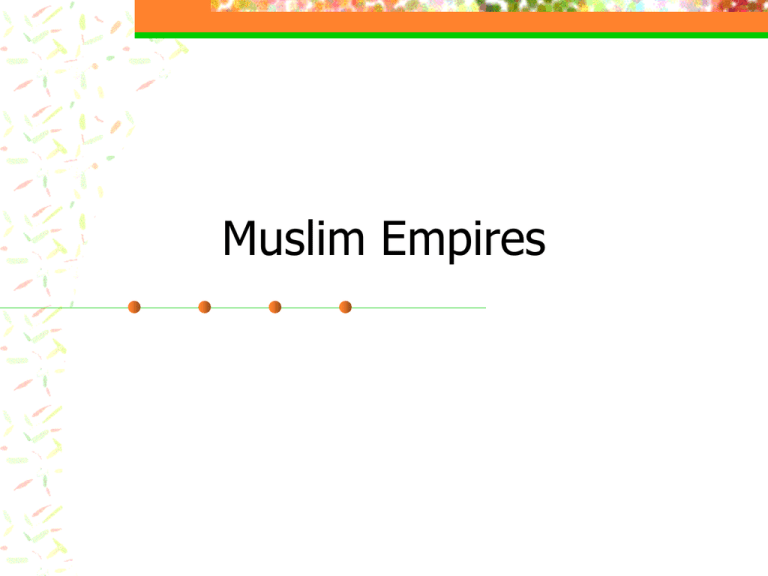
Muslim Empires The Ottomans: From Frontier Warriors to Empire Builders Last decades of 13th century Turkic peoples flooded the region (Asia minor) Osman, ghazi and leader of the Ottomans in Anatolia By 1350s Ottomans had advanced from Asia Minor across Bosporus straits into Europe 1453 Mehmed II “The Conqueror” captured Constantinople Total area under rule included Northern Africa, Balkans, parts of Iraq, Syria, Medina, Mecca Became a formidable military power 1683 siege of Vienna. Defeated but showed their power in Europe, which would stay until the late 19th century A State Geared to Warfare Military leaders played prominent role in Ottoman state- development of warrior aristocracy From mid-15th century armies dominated by infantry divisions made up of troops called Janissaries- boys sent to army- legally slaves but given schooling for the time and converted to Islam The Sultans and Their Court Monarchs who kept their positions by playing factions off of each other (warrior elite against janissaries) and kept commerce under control since Christians and Jews were under the protection of the rulers Effective rulers in early years- effective administration and tax relief for people annexed to the empire Viziers- carried out day-to-day administration and sometimes controlled more than the sultan himself Suffered because they inherited Islamic principles of political succession that remained vague and contested Constantinople Restored and the Flowering of Ottoman Culture Revitalization after capture in 1453 (Hagia Sofia turned into grand mosque, new palaces, mosques) Suleymaniye- most spectacular mosque built under Suleyman the Magnificent (r.1520-1566) Cultural life (coffee houses, intellects, architecture) Control of commerce Language- early on Arabic and Persian and later Turkic by 17th century The Problem of Ottoman Decline Dynasty endured for 600 years, one of the longest in history Its slow decline is testament to the strength of its internal structures (decline from 17th century onward) Empire too large to maintain. It was built on war and territorial expansion. When that ran out the task of effective governance was too great Crisis in leadership. Great warrior-leaders of earlier centuries gave way to weak and incompetent rulers Increase in civil strife Military Reverses and Ottoman Retreat Growing outside challenges (w. Europe, Russia, Safavids) Reliance on huge siege guns and no military change let it fall farther behind their European rivals in art of war Naval defeat at battle of Lepanto by Spanish and Venetian fleet in 1571- lost control of the Mediterranean Failure to drive Portuguese out of Asia Late 16th century silver bullion from new world flooded markets and began inflationary trend Trade and warfare were biggest developmental gaps between Ottomans and Europeans (didn’t take Europe seriously)- 17th18th centuries conservatives blocked reforms The Shi’a Challenge of the Safavids Like Ottomans, dynasty arose from struggles of rival Turkic nomadic groups in the wake of the Mongol and Timurid invasions and rose to prominence as the frontier warrior champions of highly militant strain of Islam- Shi’a variant Origins in a family of Sufi mystics- early 14th century Sufi- Sail al-Din began a campaign to purify and reform Islam Red Heads (Safavid followers because of head gear) Ismail emerges as leader after victories on battlefield. 1501 becomes shah (emperor) Began to expand borders for next century Met Ottomans at battle at Chaldiran in northwest Persia (demonstrated importance of muskets and field cannon in the gunpowder age) but Ismail’s cavalry was no match for the strong Ottomans. Outcome determined that Shi’ism would be confined to Persia Politics and War Under the Safavid Shahs Ismail secluded after defeat, which allowed rival Turkic chiefs to attempt to seize power Finally, Tahmasp I won throne and began restoring dynasty Shah Abbas I- empire reached its height of prosperity- built huge standing army (40,000 by end of reign), called on outside European advisors Effort to bring Turkic chiefs under control, so gave them warrior nobility status like in Ottoman empire State and Religion Persian influence in language and religion Claimed descent from one of the Shi’a imams (successors to Ali) as status of rulers increased Faith became a major pillar of dynasty and empire. Mullahs (local mosque officials and prayer leaders) supervised by the state and supported by the state Bulk of population converted to Shi’ism Shi’ism became integral part of Iranian identity Elite Affluence and Artistic Splendor Abbas I established empire as a major center of trade and Islamic culture, roads and trading networks set up, capital at Isfahan, great mosques Society and Gender Roles: Ottoman and Safavid Comparisons Both dominated by warrior aristocracies which gradually retread to the estates making it difficult for peasants Both encourages growth of handicraft production Women faced legal and social challenges in both However, some recent evidence points to many women being active in trade and some in money-lending The Rapid Demise of the Safavid Empire Abbas’ fears of usurpation by his sons led to the death or blinding of all of them, so weak grandson put on the throne and he couldn’t deal with the foreign threats to the empire or the factional disputes and rebellions 1722 Isfahan besieged by Afghani tribes The Mughals and the Apex of Muslim Civilization in India Babur, founder of the dynasty, was descended from Turkic warriors and fought for control over his homeland in Central Asia not for religious reasons 1498, after father’s death, Babur (16 yrs old) struggles to fight for control of homeland. Went to India for booty. Did not intend conquest at the beginning 1526 Babur defeats India’s Lodi dynasty and within 2 years had conquered large portions of the Indus and Ganges plains and established a dynasty that would last more than 300 years Babur better conqueror than leader- despite a highly refined taste for the arts. He died in 1530 and son Humayan took over, but Humayan not very successful Akbar and the Basis for a Lasting Empire Akbar, son of Humayan, took power at 13 yrs old became greatest leader and rivaled other great leaders of the time like Elizabeth I, Suleyman, Shah Abbas, etc. He built the military and administrative systems of the empire social reforms- reconciliation and cooperation with Hindu princes and the Hindu majority, encouraged intermarriage abolished jizya- head tax for non-believers promoted Hindus to high ranks new faith called Din-I-Ilahi- it was supposed to unite the subcontinent but didn’t control of local affairs in hands of military retainers of Social Reform and Social Change improve the calendar position of women- encourage widow remarriage and discouraged child marriages, legally prohibit sati, encouraged merchants to have a women’s day Mughal Splendor and Early European Contacts Akbar died in 1605 leaving Jahangir and Shah Jahan as successors, under whom India reached its splendor Delhi, Agra, Lahore 17th century India a destination place for European traders Artistic Achievement in the Mughal Era Both Jahangir and Shah Jahan wanted the good life and oversaw the building of great construction during their reigns Taj Mahal Court Politics and the Position of Elite and Ordinary Women Nur Jahan, Jahangir’s wife, wielded great power as did Mumtaz Mahal Position of women at Mughal court improved but in the rest of Indian society it declined. Child marriage more popular, widow remarriage died out, seclusion for upper-caste women The Beginnings of Imperial Decline Aurangzeb not strong enough leader to quell the rising discontent in the empire and he made two mistakes: renewed conquest for territory and attempt to remove Hindu influences in Islam In warfare he was somewhat successful but he drained the dynasty of all resources Disruption of the social peace Rise of Sikhs Write Comparative Sentences Compare the Islamic empiresOttomans, Safavids, and Mughals Compare the earlier Islamic dynasties (Umayyads and Abbasids) with these Islamic empires Compare the reaction of each to the Europeans
